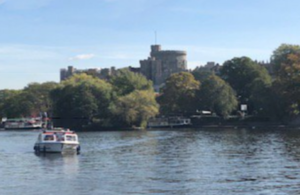Stay safe this Easter in and around the Thames
Tips on how to enjoy the river without incident.

An Environment Agency patrol boat on the Thames at Windsor
School’s out for Easter, and there is no better time to enjoy the beauty of the River Thames than over the holidays, when you can have fun, get close to nature and spend time with friends.
As the navigation authority for the non-tidal stretch of the river – from Cricklade in Wiltshire, to Shepperton in south-west London - the Environment Agency is asking parents and guardians to warn children and young people about the dangers of playing by its locks, weirs, bridges, and anywhere else in and around the Thames. Guidance available online has lots of good advice, but the overall message is clear: vigilance can save lives, and water-related accidents can be avoided by knowing how to stay safe.
Top tips for river safety:
- don’t jump or dive in as the depth may vary and there can be unseen hazards
- don’t go in near weirs, locks, pipes and sluices. These and some other water features are often linked with strong currents
- inland waters can be very cold no matter how warm the weather. Those going into cold water can get cramp and experience breathing difficulties very quickly
- keep a look out for boat traffic. Boaters especially on larger boats can find it very hard to spot and therefore avoid swimmers. Wear a bright swim cap and keep tucked into the river banks
Most importantly, parents and guardians can help keep children in their care safe by:
- teaching them to swim
- warning them not to go into water alone, or unsupervised
- ensuring they know where the children are and what they are doing
- supervising them closely when near any open water
Drowning can occur very quickly even in shallow water and the key to keeping safe is to take all necessary precautions to avoid getting into difficulty in the first place.
Experience shows it is often young people who get into trouble whilst swimming in open water, which contains hazards, particularly in and around structures such as locks, weirs and bridges. Unexpectedly cold waters or strong currents can also catch bathers off-guard.
Youngsters are often seen jumping off the many bridges along the Thames. While this may seem like great fun, there are hidden dangers in the water that can cause tragic consequences.
Russell Robson, waterways operations manager for the Environment Agency in the Thames Valley and south-west London, said:
Easter is always a busy time on our rivers, especially if the weather is good! We expect the River Thames to be a focal point for a lot of people’s leisure time, whether out in a boat, taking a dip, or just hanging out by the riverside. But we urge parents and guardians to supervise younger children closely in and around water. Teenagers and young adults should be warned of the dangers and to remember some basic safety points when out having fun.
We’d really like people to read and act upon our online water safety advice; it’s so important. There is more advice available online too, produced by the Royal Society for the Prevention of Accidents, the Canal and River Trust and others.
One of the main risks is cold-water shock, which can have a dramatic effect on your body, such as causing you to breathe in water, make your muscles weaken, and can even cause your heart to go into abnormal rhythms, ultimately resulting in death. You also have no idea what’s beneath the surface of the water: there could be unseen currents and reeds, which could pull you under.
In an ideal world, no-one would get on or in the river alone, so there would be someone around to help if they did get into any difficulties. Anyone out in any kind of boat should wear a lifejacket, just in case.
As for swimming in the Thames, we’d really rather people didn’t do it unless it’s part of an organised and supervised event. Swimming should be confined to swimming pools and lidos.